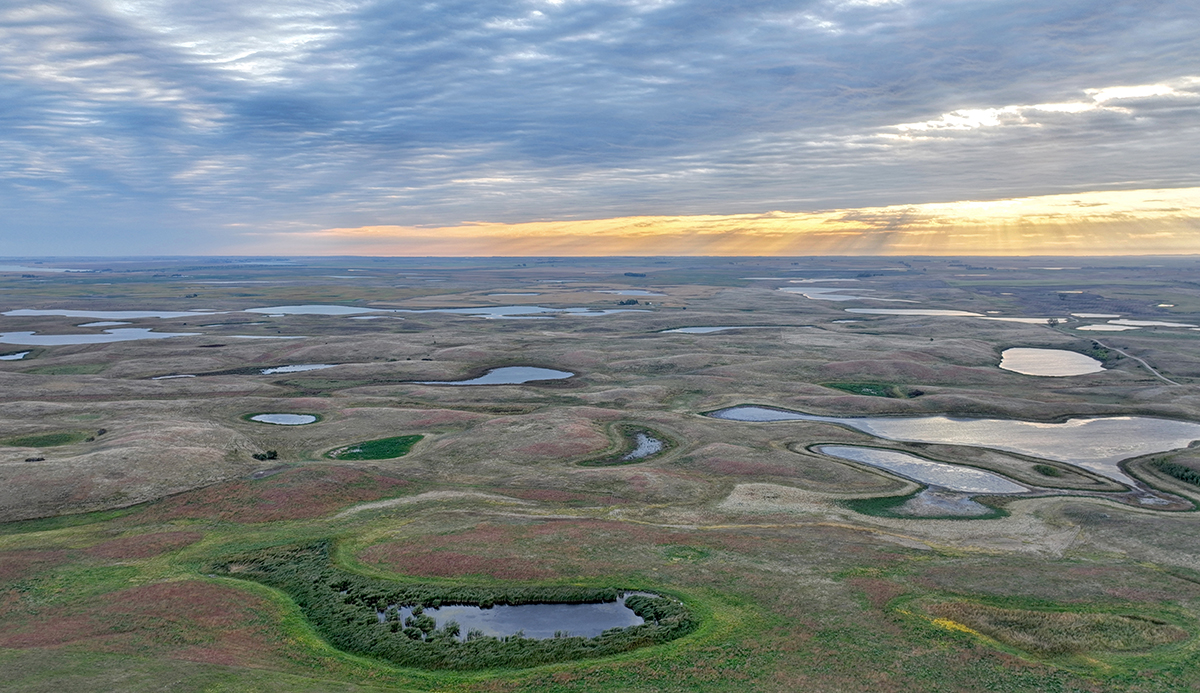North Dakota Conservation Programs

The Prairie Pothole Region in North Dakota is one of DU's highest priority landscapes. DU works with farmers, ranchers, and other partners in the region to provide a variety of working-land conservation options that meet landowner objectives and support wildlife habitat conservation. Conservation staff can provide financial and technical assistance to help landowners develop grazing systems, improve soil health, restore habitats and navigate the suite of programs available through federal, state, and non-government organization conservation partners.
Some North Dakota farmers and ranchers are concerned about soil salinity or an area of erosion on their properties. Other landowners want to attract more wildlife or improve their land for the next generation. DU’s Conservation Program Biologists help landowners evaluate conservation programs that can solve problems, like finding new uses for marginal cropland, enhancing grasslands, or improve soil health on croplands, and can help landowners walk through any applications for programs that will suit their needs.
 The NAWCA Working Lands Program
The NAWCA Working Lands Program
Are you interested in increasing your grass productivity and livestock herd size at the same time? Are you interested in making your land drought resistant? North American Wetlands Conservation Act (NAWCA) projects focus on retaining, enhancing, and creating grassland habitat ithrough grazing infrastructure and rotational grazing.
 Grassland Enhancement Pilot Program (GEPP)
Grassland Enhancement Pilot Program (GEPP)
Producers with an interest in improving grazing systems on leased lands can with Ducks Unlimited's GEPP. Project partners work with lessees and and managers to advance grazing systems on school trust and public land. Implementing a planned rotational grazing system improves grassland health, drought tolerance, and enhances recreational opportunities for the public.
 Cover Crop and Livestock Integration Project (CCLIP)
Cover Crop and Livestock Integration Project (CCLIP)
These projects aim to increase the profitability of your farm using regenerating soil practices like reducing tillage, planting diverse cover crops, and rotational grazing.
 Working Grassland Partnership (WGP, Natural Resources Trust)
Working Grassland Partnership (WGP, Natural Resources Trust)
The WGP promotes livestock grazing as a management tool for improving grassland bird conservation. WGPs provide landowners with voluntary options to help develop expiring Conservation Reserve Program acres into livestock grazing systems.
Additional programs include the Conservation Reserve Program (CRP), Environmental Quality Incentives Program (EQIP), Agricultural Conservation Easement Program (ACEP), Public Land Open to Sportsman (PLOTS), and Wetland/Grassland easements. Most programs can be coupled with others to address multiple resource concerns. For example, a landowner can choose to enroll pasture acres into the North Dakota Game and Fish Department’s PLOTS program and a Ducks Unlimited NAWCA project.

 TANNER GUE—Manager, North Dakota Conservation programs
TANNER GUE—Manager, North Dakota Conservation programs
tgue@ducks.org
701.595.6945
 DANE BUYSSE—Biologist
DANE BUYSSE—Biologist
dbuysse@ducks.org
701.425.4852
 SAM KROHN—Biologist
SAM KROHN—Biologist
skrohn@ducks.org
701.934.1635
 EMILY SCHWARTZ—Agronomist
EMILY SCHWARTZ—Agronomist
eschwartz@ducks.org
701.805.1987
 ROBERT FORD—Biologist
ROBERT FORD—Biologist
rford@ducks.org
701.230.2141
 WILLIAM PALARSKI—Biologist
WILLIAM PALARSKI—Biologist
wpalarski@ducks.org
701.390.7382
Ducks Unlimited North Dakota Resources
Ducks Unlimited Partners in North Dakota
Ducks Unlimited uses cookies to enhance your browsing experience, optimize site functionality, analyze traffic, and deliver personalized advertising through third parties. By continuing to use this site, you agree to our use of cookies. View Privacy Policy